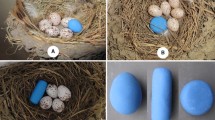Summary
Five definite and nine suspected cases of infanticide were documented in the swallow Hirundo rustica. Unmated males visited neighbouring nests and removed entire broods during the first days of the nestling period, preferentially from nests owned by young late-breeding individuals. Infanticide followed the disappearance of the male nest owner in 11 of the 14 cases. The unmated infanticidal male later mated with the female victim although renesting during the same season only took place in 12 of the 14 cases. The fraction of unmated males increased with colony size, and infanticide was relatively more common if unmated males were abundant. Females did not engage in extra-pair copulations in order to avoid infanticide. Intense guarding of the nest and its contents prevented infanticide. Nest guarding intensity was higher in colonial compared with solitarily breeding swallows, and guarding intensity increased with colony size. Experimental removal of male swallows during the early nestling period reduced the nest guarding intensity and increased frequency of visits from unmated males in colonies, but not among solitarily breeding swallows. Colonial nests from which the male was removed suffered from infanticide more often than solitary nests, and nests where infanticide was recorded were guarded significantly less intensely than other nests before the infanticidal incidents.
Similar content being viewed by others
References
Allen RW, Nice MM (1952) A study of the breeding biology of the purple martin (Progne subis). Am Midl Nat 47:606–645
Altmann J, Altmann SA, Hausfater G (1978) Primate infant's effects on mother's future reproduction. Science 201:1028–1030
Birkhead TR, Atkin L, Møller AP (1987) Copulation behaviour of birds. Behaviour 101:101–138
Crook JR, Shields WM (1985) Sexually selected infanticide by adult male barn swallows. Anim Behav 33:754–761
Emlen JT (1952) Sociol behavior in nesting cliff swallows. Conder 54:177–199
Freed LA (1986) Territory takeover and sexually selected infanticide in tropical house wrens. Behav Ecol Sociobiol 19:197–206
Ford NL (1983) Variations in mate fidelity in monogamous birds. Curr Ornithol 1:329–356
Goldstein H, Eisikovitz D, Yom-Tov Y (1986) Infanticide in the palestine sunbird. Condor 88:528–529
Hausfater G, Hrdy SB (1984) Infanticide: comparative and evolutionary perspectives. Aldine, New York
Hrdy SB (1981) The woman that never evolved. Harvard University Press, Cambridge, Mass
McKinney F, Cheng KM, Bruggers DJ (1984) Sperm competition in apparently monogamous birds. In: Smith RL (ed) Sperm competition and the evolution of animal mating systems. Academic Press, Orlando, pp 523–545
Mock DW (1984) Infanticide, siblicide, and avian nestling mortality. In: Hausfater G, Hrdy SB (eds) Infanticide: comparative and evolutionary perspectives. Aldine, New York, pp 3–30
Møller AP (1985) Mixed reproductive strategy and mate guarding in a semi-colonial passerine, the swallow Hirundo rustica. Behav Ecol Sociobiol 17:401–408
Møller AP (1987a) Intraspecific nest parasitism and anti-parasite behaviour in swallows Hirundo rustica. Anim Behav 35:247–254
Møller AP (1987b) Behavioural aspects of sperm competition in swallows Hirundo rustica. Behaviour 100:92–104
Møller AP (1987c) Advantages and disadvantages of coloniality in the swallow, Hirundo rustica. Anim Behav 35:819–832
Rohwer S (1986) Selection for adoption versus infanticide by replacement “mates” in birds. Curr Ornithol 3:353–395
Siegel S (1956) Nonparametric statistics for the behavioral sciences. McGraw-Hill, Kogakusha, Tokyo
Sokal RR, Rohlf FJ (1981) Biometry. Freeman, San Francisco
Author information
Authors and Affiliations
Rights and permissions
About this article
Cite this article
Møller, A.P. Infanticidal and anti-infanticidal strategies in the swallow Hirundo rustica . Behav Ecol Sociobiol 22, 365–371 (1988). https://doi.org/10.1007/BF00295106
Received:
Accepted:
Issue Date:
DOI: https://doi.org/10.1007/BF00295106




